
Text © DrSc Giuliano Russini – Biologist Zoologist

English translation by Mario Beltramini
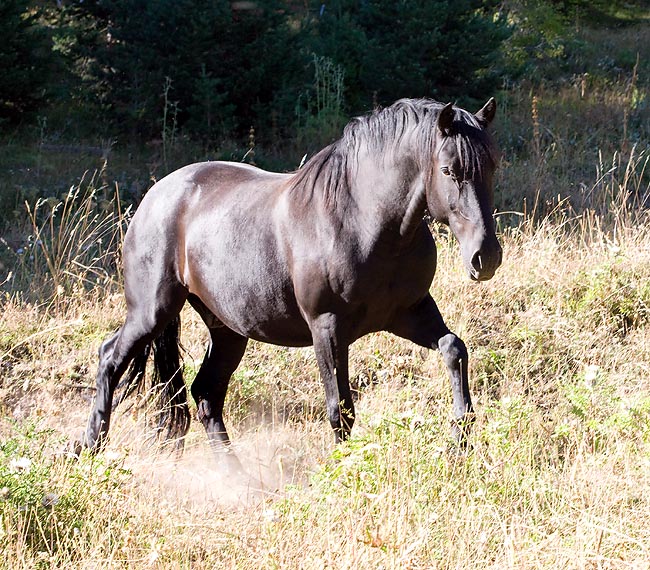
The Horse (Equus caballus) is today the noblest Perissodactyla’s member © Giuseppe Mazza
Since the beginning of the Cainozoic (Tertiary era), we find, in the multitude of forms of mammals which have differentiated starting from the progenitor line of the insectivores, several species tending to acquire rather big dimensions and a vegetarian alimentary diet.
The oldest ones of these species, it seems, nourished of tree leaves and of shrubs; many later forms did utilize as food the grasses of the prairies which had widely developed by the middle of the Cainozoic.
The molar teeth, originally rather small and sharp at the extremity, had transformed and had given room to large crowns forming powerful tools for grinding even the most coriaceous vegetable material.
Whilst the most primitive forms were stocky and usually badly organized for the running, many of these herbivores, typical of the Cainozoic forests and lawns, had evolved to become very fast; that was the only means they had for escaping their predators and for quickly go through the vast grassy lands.
The limbs in many cases became long and thin, and instead of setting on a palm and the palmar sole (plantigrades), many of them did learn to run on the tips of the toes (digitigrades), reinforced by strong and corneous hooves, as a result of the transformation of the ancestral claws. Hoof in Latin is “ungula” and it is for such reason that this crowded number and types of living forms are classified by the zoological biologists and paleontological biologists under the generic term of Ungulates (Ungulata) or mammals with hoof; also defined as unguligrade.
This vast taxonomic group, finds however its rational subdivision in two fundamental orders, which are that of the Perissodactyls (Perissodactyla) and that of the Artiodactyls (Artiodactyla). A certain number of ungulates, with a rather archaic organization, had already appeared in the Palaeocene (beginning of the Cainozoic or Tertiary era) and these old forms remained common during the following epoch, the Eocene.A typical and well known species of this group is the Phenacodus, which lived in the Europe and northern America lower Eocene.
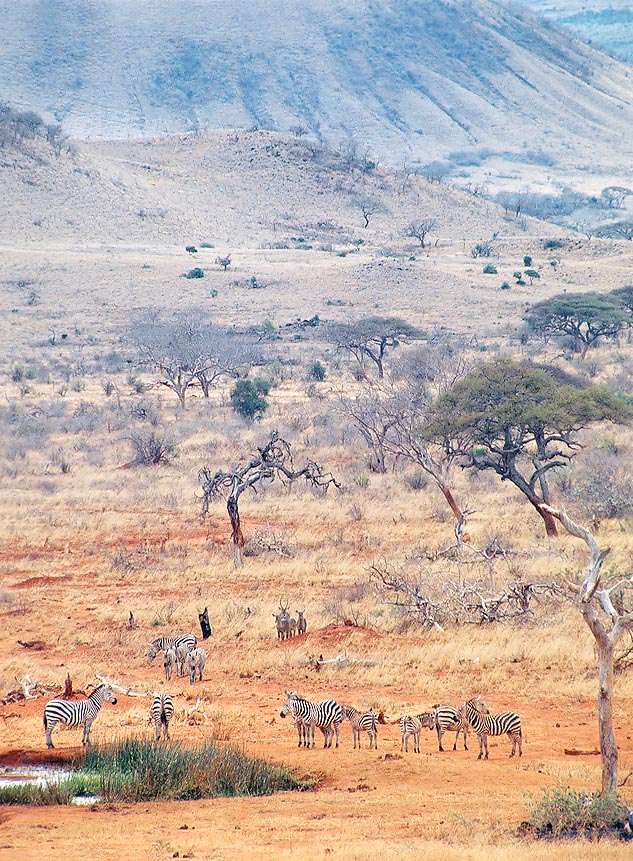
Its ancestor lived in the forests soft soil, had 3-4 support toes of no use in the savannah © Giuseppe Mazza
This herbivore had already reached a respectable size and was almost as big as the present tapir.
Due to its dimensions, the Phenacodus is similar, in a way, to the archaic carnivores living in those times, the Creodonts (Creodonta), as the body and the tail are long and the limbs still very short and of primitive structure.
Anyhow, we already find in this animal some of the characters proper of an ungulate, considering that in many of the succeeding ungulates we note a reduction of the number of the toes.
As a matter of fact, the Phenacodus has kept the original and complete number of toes, but each one of these is covered by a small hoof. For what the molars are concerned, even if their crowns are low, so much to be defined as “brachydont” teeth, they appear already widened and suitable for chewing the vegetable food. The Phenacodus itself is somewhat too big and too recent fro being considered as the true precursor of the subsequent groups of ungulates, but it is typical of a primitive order of placental mammals, the Condylarths (Condylarthra), who lived between the Palaeocene and the Eocene, which includes the initial line of a quantity, if not of all, of evolution lines of ungulates.
Many of the groups derived from this line proved aberrant one way or another, as a consequence the zoological evolutionary branch of belonging extinguished or did abort. In just a few lines we shall treat, before entering the world of the perissodactyls, these archaic vestigial forms that have been lost in the mists of time.
Nowadays, the herbivorous (or phyto- phagous) mammals populating the Earth belong, in most cases, to two main orders, both digitigrade. One is that presenting an uneven number of toes and, for this reason, is called as the one of the “imparidigitate”, that is, that of the Perissodactyls (Perissodactyla), where the weight of the body, relying only on a single toe, leads them to be called also as “mesoaxones”; the other is that of the “paridigitate”, that is, the Artiodactyls (Artiodactyla), where the foot is formed an always even number of toes, 2 or 4 depending on the group; as the weight of the body passes between the third and the fourth toe, its is also called “paraxones”.
We wish to treat, briefly, before starting to discuss about the perissodactyls, of those zoological branches which, before evolutionarily aborting, have generated transitory aberrant forms of herbivorous animals. These archaic ungulates, which at the time of their disappearance had not yet taken an evolutionary direction neither towards the perissodactyls, nor towards the artiodactyls, had a quite particular structural scheme, which had a poor evolutionary success. Among the successful perissodactyls and artiodactyls, le evolution and the specialization usually progressed at a slow or very moderate pace, the increase of the size realized, therefore, very slowly, a form of “bradytely” speciation.
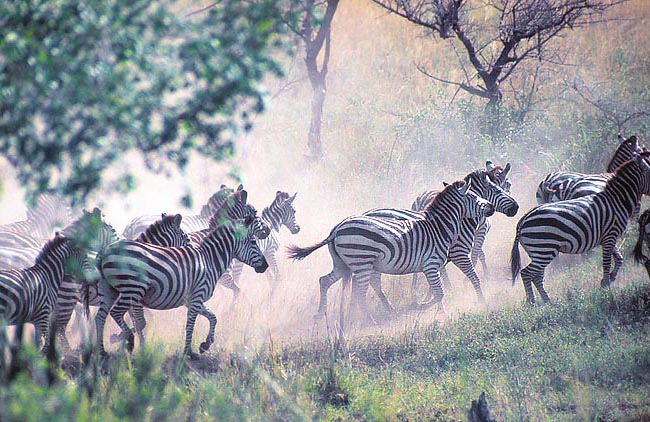
They developed the hoof, one toe only, to run on the hard soil as fast as these zebras © Giuseppe Mazza
The history of some archaic forms is completely different. For instance, the Pantodonts (Pantodonta) and the Uintatheres (Uintatheriidae), herbivorous placentate mammals which appeared in the Palaeocene epoch, Cainozoic era, before the perissodactyls and the artiodactyls, reached huge dimensions very quickly and very quickly they disappeared; a form of “tachytely” speciation, that is, charac- terized by an extremely fast growing kinetics and speciation.
Amongst the pantodonts are known some Palaeocene animal species which had already a remarkable size: the species Coryphodon is the best known by the paleontological biologist; it dates from the lower Eocene and was present in America as well as in Europe.
Contemporary to the small Eohippus (a progenitor of the present Equus caballus), this animal had a height at the withers varying from 1,20 m to 1,50 m, a stocky structure and rather short limbs, poorly suitable for running. The uintatheres, of the order of the Eocene Dinocerates (Dinocerata) group of North America, rightly appeared after the pantodonts; in fact we start having news of them, by means of fossils, by the end of the Palaeocene and all over the Eocene. But, similarly to the pantodonts, they acquired huge dimensions quickly; the last form of the end of the Eocene, had a size similar to that of the African white rhino, and they were giants for that time. These heavy herbivores, pantodonts and uintatheres, moved slowly in the immense prairies of the Tertiary, thus furnishing preys to the carnivores located there.
The Coryphodon and uintatheres had sharp tusks, which probably they utilized for defence; the uintatheres developed also three pairs of horny protuberances, distributed in length on the long and flat skull. Still now, the palaeontologists and the palaeobiologists do not have enough information for understanding if these archaic ungulates have disappeared due to the predation, or to the incapacity to compete with more evolved animals: what is by sure known is that they did disappear quite quickly.
Simpson (1971) classifies the Perissodactyls in the following way:
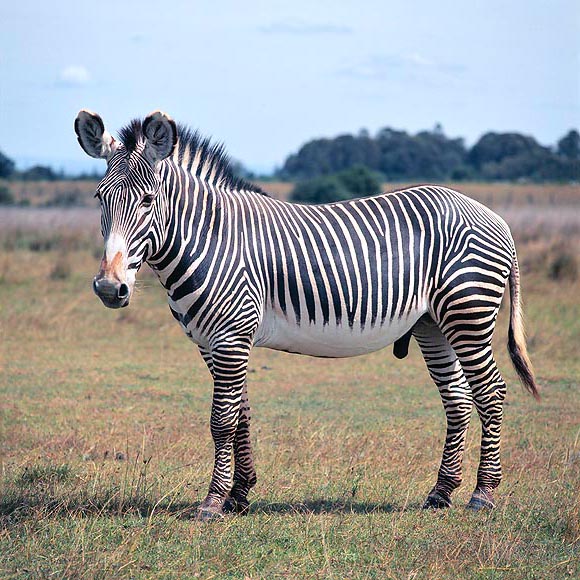
At first the size was modest then they became big and strong like this Equus grevyi © Giuseppe Mazza
Suborder: Hippomorpha
Superfamily: Equoidea
Family: Palaeotheriidae, extinct
Family: Equidae
Superfamily: Brontotherioidea
Family: Titanotheria, extinct
Suborder: Ancylopoda
Family: Chalicoteria o Ancylopoda, extinct
Suborder: Ceratomorpha
Superfamily: Apiroidea
Family: Isectolophidae, extinct
Family: Helaletidae, extinct
Family: Lophiodontidae, extinct
Superfamily: Rhinocerotoidea
Family: Hyracodontidae, extinct
Family: Amynodontidae, extinct
Family: Rhinocerotidae
Family: Tapiridae
The perissodactyls include, among the extant forms, the horses (including donkeys, the zebras and allied), the rhinos and the tapirs. This order is represented nowadays by a rather small number of genera and species. They were much more abundant during the first times of the mammal’s era and did include, by that time, two additional groups nowadays extinct, that of the Titanotheres (Titanotheria) and that of the Chalicotheres (Chalicotheria, Ancylopoda, etc.), see list.
Fundamental characteristic of this order of herbivorous mammals, placental or placentate, therefore eutherian, is that the symmetry axis of the limb passes through the middle toe of the foot.
As during their evolutionary history they have had the necessity of increasing their speed of displacement and of lifting from the ground the palm and the plantar sole for running on the tips of the toes, a reduction of the number on the sides of the medial level was the logic result. The thumb and the big toe, laterally oriented, were useless for this type of locomotion which was forming and did disappear quite soon.
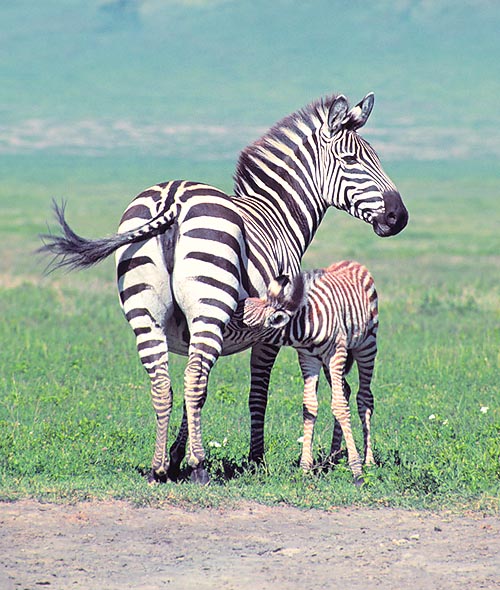
An Equus quagga boehmi nursing its foal © Giuseppe Mazza
After the successive disappearance of the pinkie, a tridactylous claw took form.
This form remained in many members of the order, but in the most recent horses; the two lateral toes reduced increasingly more and eventually aborted completely, remaining only with a monodactylous claw; which is the limb found now in the present equines.
The little finger has been more persistent in the front limb, and nowadays, for instance, in the tapirs we have a “hand” with four fingers.
However, in the horses and the rhinos, a front limb with three toes appeared quite soon in the evolution history of these families and in the equids the front limb soon became monodactylous, like the rear limb.
The Eohippus, which nowadays some taxonomical biologists call Hyracotherium, is the most ancient of the true and proper horses; for a great number of characters it seems to be much similar to the ancestral form of the whole order.
This “auroral horse” did appear at the beginning of the Eocene and its remains abound in the fossil deposits of this epoch, in particular in Wyoming, USA.
It was a small and thin animal; some individuals were as big as a fox or a puppy. The reduction of the toes had already started, but there still were four functional toes in the fore limb and three on the back one. The molars were well developed but had a very low crown and were utilized only for chewing leaves and other vegetables with mild consistency.
These prehistoric horses lived in the clearings of the forests; their teeth were therefore adapted to the food offered by that sort of vegetation and their limbs, equipped respectively with three and four supporting toes adapted quite well for allowing an important displacement speed on a soft soil.
By the beginning of the Eocene, all along this epoch and also the Tertiary following ones, the Eohippus lived in Eurasia as well as in North America. However, by the mid and the end of the Eocene, in some areas, it was replaced by little differing other genera and even quite less common than itself.
The Mesohippus, of the North American Oligocene, represents a very modest evolutionary progression. It was a little bigger horse, reaching, as an average, the size of a sheepdog; the “pinkie” had totally disappeared.
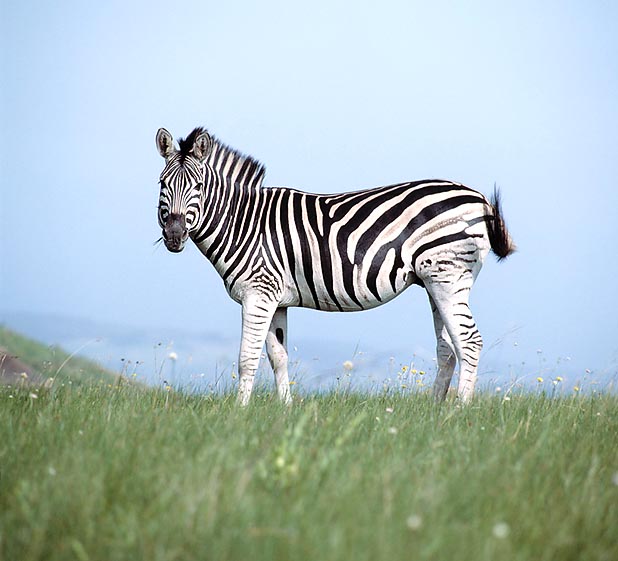
Equus quagga burchellii. Prairie is the habitat where these animals developed © Giuseppe Mazza
Apart these details, few other variations did happen compared to the Eocene form.
We still have to deal with animals grazing in the forest. Similar forms, whose size did progressively increase, but whose structure remained constant, maintained in decreasing number during the Miocene and in the first part of the Pliocene. One of them, the Anchitherium, reached Europe through the Beringia, a land bridge, long 1700 km, nowadays disappeared as it is replaced by the Bering Strait, where the horses had disappeared since long time.
But during the Miocene there was a new evolution phase for the horses. Precisely in this period of the Cainozoic era did appear, in botanical and ecological terms, the prairies, whilst the plains became more and more abundant and vast. By then came, due to the selective-ambient pressure, a new modality of life which led to the generation of the herbivores of the prairies; in this way, the evolution line of the horses modified in very clear and relatively fast manner, for occupying this new “ecological niche”, full of resources.
The grasses which covered these wide fields did contain a certain percentage of silica (similar to glass), as the paleo-botanists have shown, and therefore were very hard for the teeth. The Miocene horses, like the Merychippus, adapted themselves, therefore, to such diet thanks to the development of teeth with high crown, called “hypsodonts”, capable to resist to a long and intense utilization.
The soil of the prairies where more stable, hard and firm than that of the woods and the forests, and it was then possible to reach much higher speeds. As a consequence, in the Miocene horses appeared the tendency to reduce the lateral toes for leaning on one only toe, long and thin. This type of adaptation led to the birth of a Pliocene horse, the Pliohippus, which had the size of a pony and which, but the persistency of tiny lateral toes and the dimensions, was absolutely similar to the present horse of the genus Equus.
Another evolutionary affirmed genus, the Hipparion, invaded Eurasia and even reached Africa. These genera, by the end of the Pliocene, were followed by the genus Equus, to which belong the present horses, donkeys and zebras.
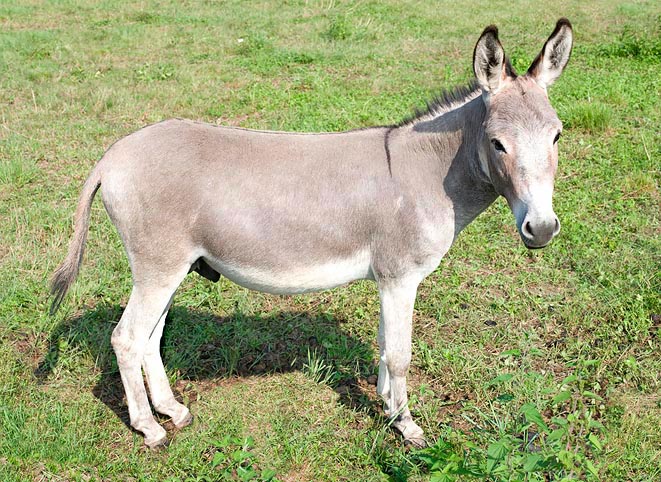
Besides the horse, man tamed the Donkey (Equus asinus) more fit as pack animal © Giuseppe Mazza
The only noteworthy change, to be evidenced, is the disappearance of the small lateral toes, disappearance which leads to the final “monodactylous” type.
Also the Equus followed the same way of the Hipparion, settling in Eurasia and in Africa.
Some equids, did reach for the first time, through the Isthmus of Panama, the South America. During the Pleistocene, horses of various types developed all over the world, but in Australia; those found nowadays there, especially in the New South Wales, in the wild, are feral varieties, therefore grown wild, of equine races imported into the continent.
But, at this stage, just by the end of the evolutionary history of the horses, we get a very strange thing. North America, as we have seen, has been the theatre where took place, step by step, the evolution of the horse. In the Pleistocene, Quaternary era, the horses went on living comfortably in North America, all along the glacial age. But then, just a few thousands of years ago, when had finally gone all the various stages of invasion and of withdrawal of the ices which had characterized the various glacial eras, Donau, Gunz, Mindel, Riss and Würm, the so-called Alpine glaciations and therefore the planet, was approaching the present climatic conditions, the horses did disappear from the New World!
When the Europeans arrived in the Americas, the horses had disappeared from the lands where they had been living for about fifty million of years, and even more. What the cause or the causes?
Actually, the biologists and the geologists tell us nowadays the disappearance of the horses from the New World was nothing less than a chapter of a more general and complex phenomenon of extinction. The horse, in fact, was not the only one to suddenly disappear, at the end of the last glacial age, amongst the numerous big mammals which were living in North America during the Pleistocene.
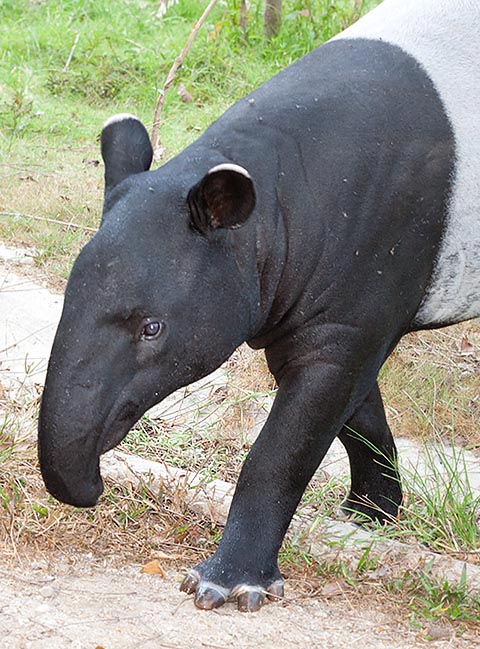
Living in the forests, the tapirs instead kept the ancestors 4 toes © Giuseppe Mazza
Arboreal sloths, glyptodonts (the ancestors of the armadillos we find now in South America), camels, mastodonts and mammoths which were running about this continent till a few thousands of years ago, have also disappeared!
From what we can understand from the fossil remains, the smaller mammals did not extinguish; but among the animals of a certain size, only the bear did survive till now, along with some species of cervids, the bison, the ram and the mountain goat (the last three are the most recent immigrants).
There has never been a clear and exhaustive explanation about the total disappearance of the great mammals of North America.
The only new element in that region at the time when such disappearance took place, is the man who arrived therefore only late in the New World.
His direct influence, through the killing of these big mammals, was therefore surely small, but it is perhaps possible that he may be one of the possible causes, or an indirect concurrent factor on their disappearance, disrupting the delicate ecological balance which ruled the internal relations of this fauna.
But let us abandon this important, unsolved problem of a general type, and go back to the evolution of the perossidactyls. A second family of survivors is that of the Tapirs (Tapiridae), presently limited to South America and Malaysia.
The present tapirs live in the forests, where they carry on a life absolutely similar to that of the Eohippus.
Furthermore, they recall this prehistoric horse as they have maintained the four toes on the fire limb and appear little different, in their morphology, from the ancient horses, if we disregard the more squat appearance, the presence of a nasal appendix in the present species and, more particular characteristic, the development on the upper molars of two transversal crests, in lieu of the complex molars we find in the equids.
In the Eocene a certain number of species similar to the tapirs, and under several aspects much alike the Eohippus, were common in Eurasia as well as in North America. The Oligocene tapirs and also those of the following epochs in the Boreal hemisphere derive from above ancestral forms. It seems, however, that the tapirs are basically animals of warm countries; it is likely that they have been driven out from their northern prairies by the Pleistocene coldness, and never did go back there.
Their presence in two tropical zones, much distant one from the other, and their absence in the regions separating them, are an excellent example of geographic distribution, phenomenon which, time ago, was much embarrassing the biologists who studied the geographic distribution of the animals.
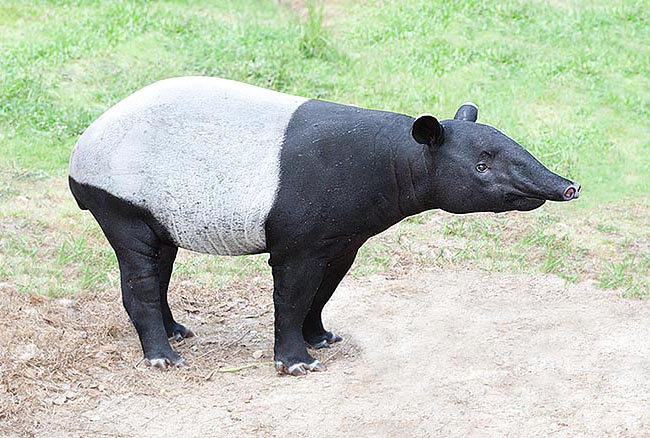
Apart the nose appendix, this Tapirus indicus doesn’t differ much from horse’s ancestors © Giuseppe Mazza
Today, the existence of species like the South American tapir (Tapirus terrestris), who lives in the swampy forests of southern America, and the Malayan tapir (Tapirus indicus), with black and white patched hair, do tell us that, as indeed happens for other animal species, that this distribution is attributable to the climatic changes.
The third and last family of extant perissodactyls, is that of the Rhinoceros (Rhinocerotidae).
The present rhinos have only few species living in the South of Asia and in Africa. They are all seriously endangered in their existence.
And perhaps an Asian species, the Sumatran Rhinoceros (Dicerorhinus sumatrensis) has most unluckily extinguished.
The present rhinoceros, all of remarkable size, are for this reason called pachyderms: heavy forms, with stocky limbs, defined “columnar”, with three toes. They are equipped with horns, more or less developed, even or uneven, not formed by bones and not even by corneous substance but is, or are, mass or masses of very thick agglutinated hairs which do not conserve in the processes of fossilization.
A distinctive character of the rhinos consists in the development on the upper molars of a sort of crest shaped like a “π” (Pi), with the crossbar on the external side of the tooth. The old Eocene species, similar to the rhinoceros and contemporary of the first horses and of the ancestors of the tapirs, were much different from the present forms. They were slender animals, good for running, with four toes in the forelimbs, without crown in the teeth and hard to identify as rhinos, if not for the particular structure of the molars.
There were still slender forms in the Oligocene, able to run quickly; for instance the Indricotherium of the medium Oligocene, tall up to five metres at the withers, living in Siberia in the grassy savannahs close to the Aral Sea, and nourishing of tree leaves.
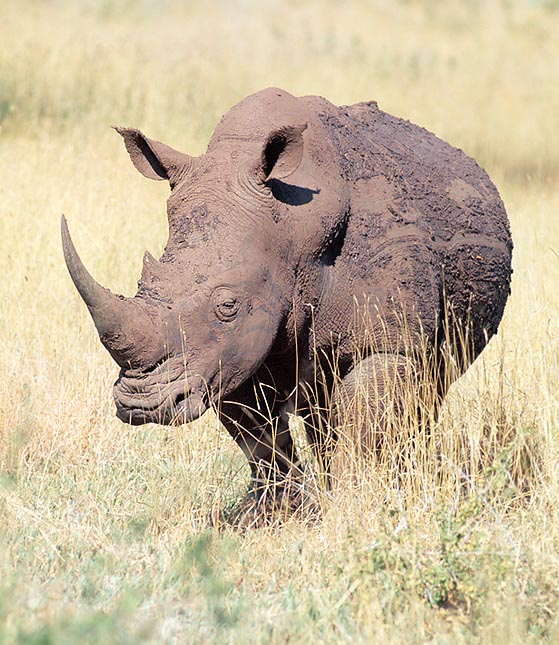
The rhinos, here a Ceratotherium simum, have on the contrary solid columnar limbs © G. Mazza
But it is right at this time that the evolution begins towards the more typical forms, which show a clear tendency to the increase of the sizes, a more massive structure, and to the loss (like for the horses of the same epoch) of the fourth fore toe. The horn, on the contrary, has taken a good deal of time before appearing.
In the Oligocene and following epochs, the rhinos were standing among the most common inhabitants of the plains in the continents of the terrestrial northern hemisphere and diversified in a huge number of forms.
The Baluchitherium of the Asian Oligocene, for instance, was almost looking like an enormous giraffe. Bulky, with a height evaluated over the seven metres, it is the greatest known terrestrial mammal. Amongst the other forms of the Tertiary, we find amphibious species with very short limbs.
In the Pleistocene, Quaternary, a woolly rhinoceros did appear, adapted to the cold climate of the glacial epochs.
Notwithstanding the old abundance of rhinoceros, the end of the Tertiary was to mark their strong numeric diminution, with their disappearance from North America and the beginning of their decline up to the modest situation, in terms of number of genera and species, of the current era.
Two last remarkable families, nowadays completely extinct, conclude the series of the perissodactyls.
The already previously cited titanotheres, whose terminal forms such as the Brontotherium, date back to the beginning of the lower Oligocene, and are particular common in the layers of the “Bad lands” of southern Dakota in USA, deserve by sure the name of “titanic animals”, as they were enormous, much bigger than the white rhinoceros, some of them even bigger than the present African savannah elephant (Loxodonta africana).
These gigantic mammals lived in the grassy plains which extended at the on the slopes of the volcanic chains in activity at that time. They were slow pacing animals and for this reason they could be easy preys of the carnivores of that time and so they developed a pair of huge bony protuberances in the nasal region. In addition to northern America, where they were native to, they were present also in Asia. The forms of the early Eocene of these huge herbivorous mammals did not much differ, as it happens for the rhinos and the tapirs, from the horses of that epoch, but it was evident already a clear tendency to reach bigger dimensions.
After the lower Eocene, these forms, once abundant, disappear totally. The cause of their disappearance is not, probably, due to their predators, but to the type of nutrition they had.
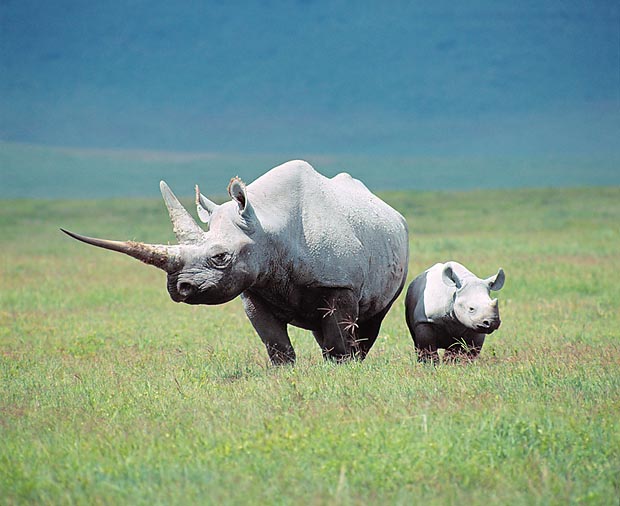
A Diceros bicornis with cub. Rhinos, common on the past, are now endangered © Giuseppe Mazza
The molars, with low crowns, were good only for vegetables of tender consistency (leaves, shoots, etc.); an even slightest variation in the composition of the flora in their areas was therefore sufficient for causing the death from starvation of the titanotheres and for their extinction.
Lastly, the chalicotheres or ancylopoda, like the Moropus, again, did appear for the first time with the Eocene, from ancestors little different from the first horses; but followed another evolutionary direction or branch.
The overall proportions of the body were remarkably close to those of the horses, the teeth, on the contrary, were totally similar to those of the titanotheres.
For what the limbs are concerned, the chalicotheres did invent a particular structure, in which the toes did not end in a hoof each, but in enormous claws, probably utilized for digging the soil when looking for tubers, roots, rhizomes. Even if abundant in the deposits of the Tertiary, they did completely disappear just after the beginning of the Pleistocene.
